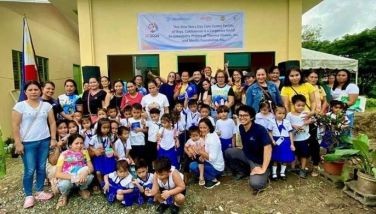Mindanao community moves for better education
MANILA, Philippines - Poor communities in conflict-affected areas in Mindanao are finding the will and means to share the government’s responsibility in improving their children’s education.
In Binoni, a small upland village seven kilometers away from the highway in the municipality of Salug in Zamboanga del Norte, public elementary students used to walk one kilometer from school each day on rugged roads during their lunch break just to get drinking water from the nearest community water pump. Then they had to hurry back to school for their afternoon classes.
“The children returned late after their lunch break and were tired in their afternoon classes, and this affected their performance inside the classroom,” said Binoni Elementary School principal Celso Reambonanza.
Reambonanza and the school’s teachers tried to ease the burden by collecting water in jugs for them to drink, but they desired a more permanent solution.
“When we were given the chance to implement an education project, we knew what project we needed — a water system,” Reambonanza said.
The water system was funded through a Community Incentive Grant (CIG) to the school’s Parent-Teacher-Community Association (PTCA) from the US Agency for International Development (USAID), through its Education Quality and Access for Learning and Livelihood Skills (EQuALLS2) project.
USAID awards CIGs to community associations in areas affected by conflict and poverty in the Autonomous Region in Muslim Mindanao and Regions 9 and 12, that desire to help enhance basic education in their community through self-planned and self-implemented projects.
The CIGs are awarded to them after they are trained in organizational development and project and financial management, and once their grant proposals pass USAID’s criteria.
The water system was completed last June with the growth of the Binoni PTCA grant through counterpart funds and construction materials from the municipal and village government units as well as the local Department of Education division.
While programs are already in place to address major basic education challenges especially in Mindanao at the institutional level, CIGs empower communities to address education challenges at the local or school level.
“CIGs encourage PTAs in Mindanao to help improve education in their village, to link up with other education stakeholders like local school boards, and to maximize available resources in the local government structure for education,” explained Abegail Luna, the EQuALLS2 municipal coordinator for Salug from Save the Children, the project’s implementing partner in the area.
In the CIG project process, communities themselves identify the crucial needs of local in- and out-of-school children and youth, and then formulate a municipal education and skills plan that can be the basis for budget allocation for education projects in government investment plans.
Salug municipal mayor Jesus Lim is finding ways to expand the success of CIG projects by allocating counterpart funds for education projects of individual villages, including those not covered by the program.
- Latest
























